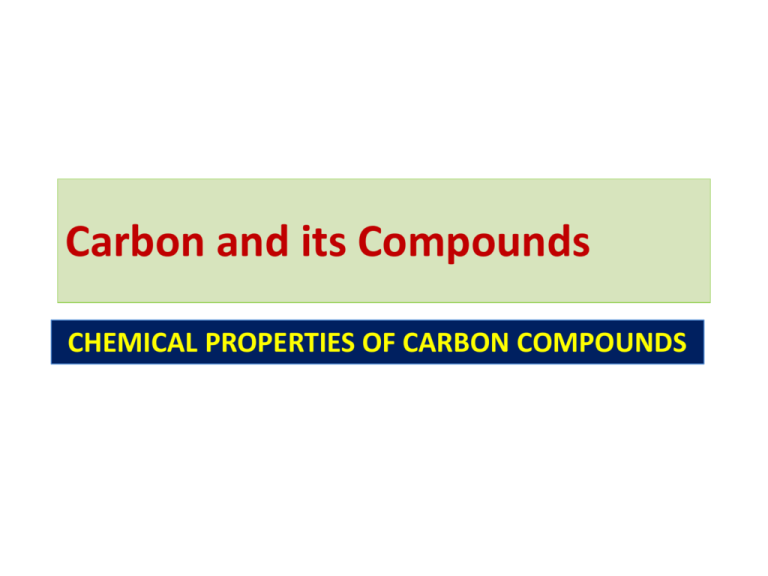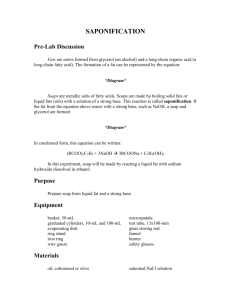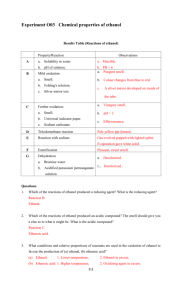Carbon and its Compounds
advertisement

Carbon and its Compounds CHEMICAL PROPERTIES OF CARBON COMPOUNDS CHEMICAL PROPERTIES OF CARBON COMPOUNDS Combustion Carbon, in all its allotropic forms, burns in oxygen to give carbon dioxide along with the release of heat and light. Saturated hydrocarbons will generally give a clean flame while unsaturated carbon compounds will give a yellow flame with lots of black smoke Why do substances burn with or without a flame? A flame is only produced when gaseous substances burn. When wood or charcoal is ignited, the volatile substances present vapourise and burn with a flame in the beginning. A luminous flame is seen when the atoms of the gaseous substance are heated and start to glow. The colour produced by each element is a characteristic property of that element. Oxidation Carbon compounds can be easily oxidised on combustion. In addition to this complete oxidation, we have reactions in which alcohols are converted to carboxylic acids – Addition Reactions: Unsaturated hydrocarbons add hydrogen in the presence of catalysts such as palladium or nickel to give saturated hydrocarbons. This reaction is called hydrogenation. This reaction is commonly used in the hydrogenation of vegetable oils using a nickel catalyst. Catalysts Catalysts are substances that cause a reaction to occur or proceed at a different rate without the reaction itself being affected. e.g. Pt, Pd, Ni, Fe, Cu are most commonly used catalyst. Substitution Reactions: In a substitution reaction one type of atom or a group of atoms takes the place of another. Saturated hydrocarbons generally undergo substitution reactions. e.g. Chlorine can replace the hydrogen atoms one by one in the presence of sunlight CH4 + Cl2 → CH3Cl + HCl (in the presence of sunlight) QUESTIONS FOR PRACTICE: 1.What do you mean by hydrogenation ? Explain with suitable example. 2.Why is the conversion of ethanol to ethanoic acid an oxidation reaction? 3. What is the role of a catalyst in a chemical reaction ? 4. A mixture of oxygen and ethyne is burnt for welding. Can you tell why a mixture of ethyne and air is not used? SOME IMPORTANT CARBON COMPOUNDS ETHANOL ETHANOIC ACID ETHANOL Production: 1.Ethanol can be produced by the fermentation of sugars and starches from many different sources 2. It can be synthesized by hydration of alkene (ethene) in the presence of suitable catalyst (conc. H2SO4 /P2O5/Al2O3). Properties of Ethanol 1.Ethanol is a liquid at room temperature . 2.Ethanol is commonly called alcohol and is the active ingredient of all alcoholic drinks. 3.Ethanol is also soluble in water in all proportions. 4. In addition, because it is a good solvent, it is also used in medicines such as tincture iodine, cough syrups, and many tonics. Reactions of Ethanol (i) Reaction with sodium – This reaction shows the acidic nature of ethanol (ii) Reaction to give unsaturated hydrocarbon: Dehydration The concentrated sulphuric acid can be regarded as a dehydrating agent which removes water from ethanol. How do alcohols affect living beings? Ethanol: When large quantities of ethanol are consumed, it tends to slow metabolic processes and to depress the central nervous system. This results in lack of coordination, mental confusion, drowsiness, lowering of the normal inhibitions, and finally stupour. The individual may feel relaxed but does not realise that his sense of judgement sense of timing, and muscular coordination have been seriously impaired. Methanol: Intake of methanol in very small quantities can cause death. Methanol is oxidised to methanal in the liver. Methanal reacts rapidly with the components of cells. It causes the protoplasm to get coagulated, in much the same way an egg is coagulated by cooking. Methanol also affects the optic nerve, causing blindness. Denatured alcohol: To prevent the misuse of ethanol produced for industrial use, it is made unfit for drinking by adding poisonous substances like methanol to it. This is called denatured alcohol. Dyes are also added to colour the alcohol blue so that it can be identified easily. Ethanoic Acid CH3COOH →Ethanoic acid is commonly called acetic acid and belongs to a group of acids called carboxylic acids. →5-8% solution of acetic acid in water is called vinegar. Reactions of ethanoic acid: 1. Reaction with a base It react with a base to give salt and water NaOH + CH3COOH → CH3COONa + H2O 2.Reaction with carbonates and hydrogen carbonates: Ethanoic acid reacts with carbonates and hydrogen carbonates to give rise to a salt, carbon dioxide and water. CH3COOH + NaHCO3 → CH3COONa + H2O + CO2 2CH3COOH + Na2CO3 → 2CH3COONa + H2O + CO2 3. Esterification reaction: Ethanoic acid reacts with absolute ethanol in the presence of an acid catalyst to give an ester,it is called as esterification reaction. Esters are sweet-smelling substances. These are used in making perfumes and as flavouring agents. Saponification Esters react in the presence of an acid or a base to give back the alcohol and carboxylic acid or its salt. This reaction is known as saponification because it is used in the preparation of soap. CH3COOC2H5 + NaOH → CH3COONa + C2H5OH SOAPS AND DETERGENTS The molecules of soap are sodium or potassium salts of long-chain carboxylic acids. The ionic-end of soap dissolves in water while the carbon chain dissolves in oil. The soap molecules, thus form structures called micelles where one end of the molecules is towards the oil droplet while the ionic-end faces outside. This forms an emulsion in water. The soap micelle thus helps in dissolving the dirt in water and we can wash our clothes clean. • Natural soaps are prepared by boiling lard or other animal fat with NaOH, in a reaction called saponification (Latin, sapo, soap). O O CH2 OCR saponification + 3 N aOH RCOCH O CH2 OCR CH2 OH A triglyceride (a triester of glycerol) CHOH + CH2 OH 1,2,3-Propanetriol (Glycerol; Glycerin) O + 3 RCO N a Sodium soaps - + COO Na Mechanism Of The Cleaning Action Of Soaps. • Their long hydrophobic hydrocarbon chains are insoluble in water and tend to cluster in such a way as to minimize their contact with water. • Their polar hydrophilic carboxylate groups, on the other hand, tend to remain in contact with the surrounding water molecules. • Driven by these two forces, soap molecules spontaneously cluster into micelles. – A soap micelle: nonpolar (hydrophobic) hydrocarbon chains cluster in the inside and polar (hydrophilic) carboxylate groups lie on the surface. micelle: A spherical arrangement of organic molecules in water clustered so that their hydrophobic parts are buried inside the sphere and their hydrophilic parts are on the surface of the sphere and in contact with water. when soap is mixed with waterinsoluble grease, oil, and fats, the nonpolar parts of the soap micelles “dissolve” these nonpolar dirt molecules and they are carried away in the polar wash water. • Soaps form water-insoluble salts when used in water containing Ca(II), Mg(II), and Fe(III) ions (hard water). - 2 CH3 ( CH2 ) 1 4 COO Na + + Ca 2+ A sodium soap (soluble in water as micelles) - [ CH3 ( CH2 ) 1 4 COO ] 2 Ca Calcium salt of a fatty acid (insoluble in water) 2+ + 2 Na + The molecules of detergents are sodium or potassium salts of long-chain sulphonic acids. They do not form water-insoluble salts when used in water containing Ca(II), Mg(II), and Fe(III) ions (hard water). 1 . H2 SO 4 2 . NaOH CH 3 ( CH2 ) 1 0 CH 2 Dodecylbenzene CH 3 ( CH2 ) 1 0 CH 2 - SO 3 Na Sodium 4-dodecylbenzenesulfonate (an anionic detergent) +





